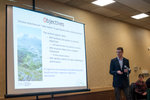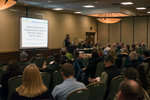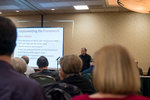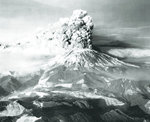



KELSO — On May 18, 1980 life in Southwest Washington changed in an instant as Mount St. Helens snapped out of slumber. The ensuing volcanic eruption caused the death of 57 people and laid waste to the landscape located in the blast zone on the northwest flank of the mountainside.
The scope of that carnage was nearly incomprehensible to those who were there to witness it, and now, nearly four decades later, scientists warn that there may be even more serious consequences to come.
Last Thursday, members of the National Academies of Sciences convened in Kelso in order to provide a briefing to the public and various government agencies regarding the findings of their recent study, “A Decision Framework for Managing the Spirit Lake and Toutle River System at Mount Saint Helens.”
That $570,000 study, released on Dec. 8, 2017, was requested by the U.S. Forest Service in 2015 in an effort to better understand the volcano-related risks associated with those water systems as well as any potential paths for improvements going forward. Thursday’s meeting was attended by about 80 individuals, including members of the U.S. Forest Service, the Army Corps of Engineers, local law enforcement agencies and politicians, including U.S. Rep. Jaime Herrera Beutler, R-Battle Ground.
“Our report stresses the importance of thinking of Spirit Lake and the Toutle River as a system,” said committee chairman Gregory Baecher, of the University of Maryland, in a report summary. “Using an analytic process that is also deliberative will help decision-makers identify the many objectives, alternatives, and impacts of those alternatives for managing that system.”
During the 1980 eruption of Mount St. Helens, the once idyllic reflection pool of Spirit Lake was inundated with the debris of the decimated forest. A mat of logs choked the lake and blocked off the natural outflow. That natural dam caused the lake to rise by about 200 feet and put roughly 50,000 people who live downriver in the Toutle and Cowlitz river valleys at risk of catastrophic flooding and mud flows in the event that the natural dam were to break.
In order to alleviate that risk, engineers constructed a 1.56 mile tunnel at the outflow end of Spirit Lake that allows operators to control the level of the lake. That tunnel was opened in 1985, and despite the need for extensive maintenance, it has mostly served its function so far.
However, according to the study conducted by the National Academies of Sciences, that tunnel does not represent a viable long term solution due to the risk of operational errors, earthquake damage and other natural forces. Additionally, the report noted that silt accumulation in the Toutle River system continues to create problems downstream. That volcano dust has nearly completely filled a silt trap constructed in the Toutle River after the eruption and as a result more and more silt is making its way downriver over time. That silt buildup is filling the river channel down into the Cowlitz River and all the way down to the Columbia River, which has resulted in increased flood risks for residents even during normal weather events.
Herrera Beutler addressed the crowd at the beginning of the meeting in order to note the need for urgent action while securing lasting change and improved safety for area residents.
“My hope is that we can prevent our children from going through this same thing due to this future planning,” said Herrera Beutler.
Due to the passive nature of the report through, Herrera Beutler was still left with many questions at the conclusion of Thursday’s meeting. As the title of the report implies, the goal was not to dictate solutions or specific plans to area land managers. Instead, the National Academies of Sciences report attempts to lay out the numerous compounding factors that make the long term management of the Toutle River and Spirit Lake so intricate.
“That’s one of the things I came away with is, what is the next step?” said Herrera Beutler.
Complicating the situation is the number of agencies with a stake in the management process. Those entities include, but are not limited to, the U.S. Forest Service, the Washington Department of Fish and Wildlife, the National Parks Service, the state Department of Natural Resources, tribal governments, county governments and the Army Corps of Engineers. As far as Herrera Beutler could tell, the Army Corps of Engineers and the Forest Service appear to be co-leads on the issue, but that is likely to change based on the specific area and type of work being conducted.
A representative for the Army Corp of Engineers who was present at the meeting stated his belief that the Spirit Lake tunnel is in no danger of failure but agreed that it is prudent to look at all management and upkeep options going forward.
One concern broached by multiple members of the public is that the Spirit Lake tunnel does not jive with the mission statement of the National Volcanic Monument where it is located. That monument is supposed to preserve the natural ecosystem so that it can repair itself according to its own devices and schedule.
That incongruity was addressed by Gregory Baecher, chairman of the study, who noted that in the aftermath of catastrophic events, priorities are often understandably skewed. In the case of Mount St. Helens, a concerted focus was placed on public safety in the years after the eruption. Nearly four decades later, Baecher said that expectations and values surrounding the management of the water systems have changed.
“The focus is always on risk after a catastrophe,” said Baecher, who suggested that it may be time to start considering other priorities in the watershed.
Baecher’s suggestion included mapping out options based on community values and objectives rather than monetary cost. He added that it is important for community members to be included in the discovery and decision making process from the start. In the end, the panel of scientists explained, the goal is to find a solution that all parties can support on some level.
“This is not a destination,” insisted Baecher. “This is a journey.”
Indeed, there was nobody in attendance on Thursday who could provide any sort of timeline for the implementation of changes to the management of the Spirit Lake tunnel or Toutle River sediment collection. The only target deadline on the table so far was proffered by the Forest Service, which stated its intention to have an environmental assessment completed by the end of this year. That assessment, if approved, would allow workers road access to the Spirit Lake outflow tunnel in order to facilitate inspections. Any brick and mortar work will likely be delayed until some time in the next decade, although no one from the Forest Service was willing to put any kind of anticipated date on any work.
“We need access to the lake right now,” said Angie Elam, deputy supervisor of the Gifford Pinchot National Forest. “We have to keep water coming out of Spirit Lake no matter what we wind up doing in the future.”
Another Forest Service employee, Sue Ripp, noted that the Forest Service will have final say on all proposals that fall within their boundaries. In the meantime, the Forest Service is seeking input from the local community in order to help guide the decision making process.
Samantha Magsino, senior program officer with the National Academies of Sciences, called the 12-person panel that conducted the study an “all-star cast.” She said that the purpose of the study was to provide a bird’s eye view on the problems at hand in order to empower local voices to make informed and final decisions.
“There is a lot of excellent expertise in this region but sometimes it’s good to take a step back and let somebody else take a look,” said Magsino. “That’s really what this group is about.”
Cowlitz County Sheriff Mark Nelson was one of the final members of the audience to address the panel on Thursday. He said that public safety should be the primary concern going forward, noting the thousands of people in his jurisdiction who are threatened by the combined flood risks of Spirit Lake and the Toutle River. The worst case scenario could send water over the banks as far away as Longview at the confluence of the Columbia River.
“I know there are people who would choose a fish over a person,” said Nelson. “I would say that if all of this effort is not for the people, then it’s not worth a whole hell of a lot, if you ask me.”
The full report from the National Academies of Sciences can be found online at nap.edu, and hard copies of the report may be obtained by calling 1-800-624-6242. Additional information, as well as a platform to comment to the Forest Service, can be found online at https://tinyurl.com/ya5v3g5h.